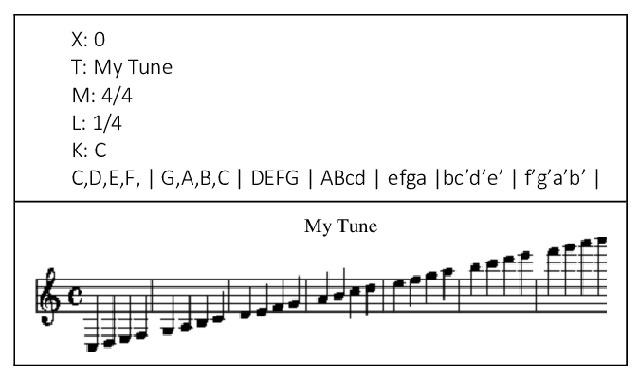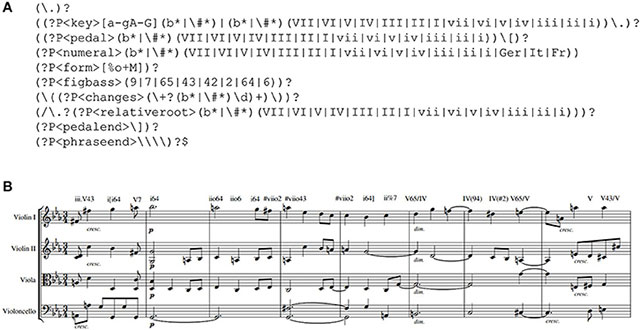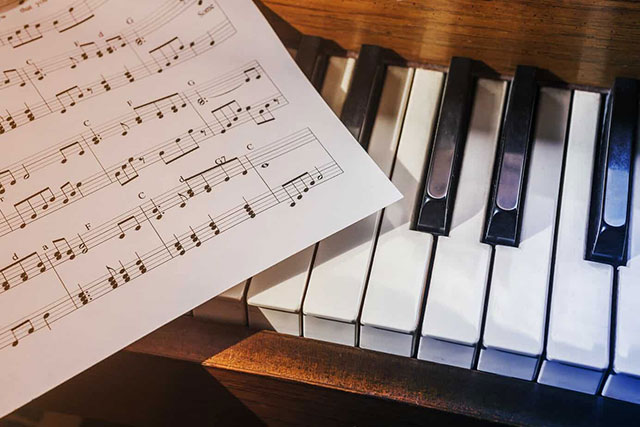 ABC music notation offers a powerful and versatile system for representing musical scores in a concise and human-readable format. Widely used by musicians, educators and enthusiasts, ABC notation provides a standardized method of capturing melodies, harmonies and other musical elements. With its simplicity and accessibility, ABC notation has become a preferred choice for sharing and preserving music across various platforms and communities.
ABC music notation offers a powerful and versatile system for representing musical scores in a concise and human-readable format. Widely used by musicians, educators and enthusiasts, ABC notation provides a standardized method of capturing melodies, harmonies and other musical elements. With its simplicity and accessibility, ABC notation has become a preferred choice for sharing and preserving music across various platforms and communities.
Click here to try our free online Sheet Music Editor, which uses ABC Notation.
The significance of ABC notation in the realm of music cannot be overstated. Its lightweight structure and intuitive syntax make it an ideal format for musicians of all skill levels to notate and exchange musical ideas. Whether you're a beginner learning a folk tune, a classical composer transcribing intricate orchestral compositions, or a songwriter documenting your latest creation, ABC notation offers a flexible and adaptable framework.
ABC notation transcends the boundaries of traditional sheet music, enabling seamless communication and collaboration between musicians worldwide. By embracing this universal format, musicians can share their creations with others, ensuring that their musical expressions remain accessible and translatable across different instruments, genres and musical cultures.
The roots of ABC notation can be traced back to the late 1970s when it emerged as a standardized method for notating folk tunes in electronic form. In the 1980s, a computer programmer and musician named Chris Walshaw developed the initial concept, aiming to create a format that could be easily shared and played using computers.
Over the years, ABC notation has evolved and expanded, incorporating new features and accommodating diverse musical styles. Its open and collaborative nature has allowed musicians and developers to contribute to its development, resulting in a vibrant community that continually refines and enhances the notation system.
Today, ABC notation has established itself as a valuable tool in the music domain, with dedicated software, online repositories and communities supporting its widespread use. Its simplicity, portability and adaptability have made it a cornerstone in the digital representation of music, democratizing musical notation and fostering a global network of musicians united by a common language.
As you can see, ABC notation has become an indispensable asset in the musical landscape, empowering musicians to capture and share their compositions with precision and clarity. In the subsequent sections, we'll delve deeper into the intricacies of ABC notation, exploring its fundamental elements, advanced techniques, practical applications and future prospects, unlocking a world of musical possibilities.
 At its core, ABC notation is a concise and expressive system for representing musical scores in a text-based format. It serves as a bridge between the musical world and digital platforms, enabling musicians to notate and share their compositions in a format that's both human-readable and machine-friendly. By utilizing a simple set of symbols and characters, ABC notation allows musicians to capture the essence of a musical piece, including melodies, rhythms, chords, lyrics and more.
At its core, ABC notation is a concise and expressive system for representing musical scores in a text-based format. It serves as a bridge between the musical world and digital platforms, enabling musicians to notate and share their compositions in a format that's both human-readable and machine-friendly. By utilizing a simple set of symbols and characters, ABC notation allows musicians to capture the essence of a musical piece, including melodies, rhythms, chords, lyrics and more.
To harness the power of ABC notation, it's essential to grasp its syntax and structure. ABC notation follows a line-by-line approach, with each line representing a musical element or directive. The lines are typically organized into sections, providing a logical structure to the composition. The placement and order of these sections vary depending on the requirements of the music being notated.
Within each line, specific characters and symbols convey musical information. For instance, notes are represented by letters, with uppercase letters denoting higher pitches and lowercase letters representing lower pitches. The duration of each note is indicated by appending a numerical value and rests are designated by specific symbols. Chords, lyrics and annotations are interspersed throughout the notation to provide additional context and instructions.
Directives, on the other hand, serve as global instructions that apply to the entire composition or specific sections. They can specify tempo changes, repeat structures, transposition instructions and more. These annotations and directives empower musicians to notate their compositions with precision, leaving little room for ambiguity.
By mastering the basics of ABC notation, musicians can effectively express their musical ideas in a format that's both accessible and accurate. In the subsequent sections, we'll explore the various elements and techniques that make ABC notation a powerful tool for musicians worldwide, empowering them to notate and share their compositions with clarity and precision.
 One of the fundamental building blocks of ABC notation is the representation of notes, pitches and rhythms. In ABC notation, notes are denoted using letters, with uppercase letters representing higher pitches and lowercase letters indicating lower pitches. This intuitive system allows musicians to quickly identify and reproduce melodies accurately.
One of the fundamental building blocks of ABC notation is the representation of notes, pitches and rhythms. In ABC notation, notes are denoted using letters, with uppercase letters representing higher pitches and lowercase letters indicating lower pitches. This intuitive system allows musicians to quickly identify and reproduce melodies accurately.
To further enhance the expressiveness and clarity of the music, ABC notation assigns durations to each note. Numeric values, such as fractions or decimal representations, accompany the notes, indicating their duration. This information guides performers on the length of time each note should be held, ensuring accurate rhythmic interpretation.
In addition to representing notes, ABC notation includes symbols for rests, which indicate periods of silence within the music. Rests serve as important pauses that contribute to the overall rhythm and phrasing of the composition. The duration of rests is specified using similar numeric values as those used for notes, ensuring synchronization between the melodic and silent elements of the music.
ABC notation provides a means to notate chords and chord progressions, which are crucial components of many musical genres. Chords are represented using a combination of letters, numbers and symbols to denote the root note, chord quality and any additional information such as inversions or extensions. By incorporating chords into ABC notation, musicians can accurately document the harmonic structure of a composition, allowing for faithful recreations and arrangements.
Chord progressions, sequences of chords that create harmonic movement, can also be notated within ABC notation. By indicating the succession and duration of chords, composers and performers gain valuable insights into the harmonic landscape of the music, facilitating accurate interpretations and improvisations.
To convey intricate musical nuances and stylistic elements, ABC notation provides a rich set of symbols for ornamentation and articulation. These symbols guide performers in executing specific techniques, such as trills, mordents, glissandos, staccatos and legatos, to name a few. By incorporating these symbols into ABC notation, composers can accurately communicate their desired musical expression, ensuring that the performance captures the intended character and emotion.
ABC notation recognizes the importance of vocal elements in music by offering a dedicated space for lyrics and text annotations. Lyrics can be aligned with the corresponding melodic notes, allowing singers to synchronize their vocalization with the music. This feature is particularly valuable in genres such as folk, pop and choral music, where lyrics play a significant role in storytelling and emotional conveyance.
Additionally, ABC notation allows for text annotations to provide additional information or instructions to performers. These annotations can include performance indications, phrasing guides, expressive markings and more. By incorporating lyrics and text annotations, ABC notation embraces the multifaceted nature of music, accommodating both melodic and textual elements.
By exploring the elements of ABC notation discussed above, musicians gain a comprehensive toolkit for accurately representing various musical aspects. From notes and rhythms to chords, ornamentation, lyrics and annotations, ABC notation provides a versatile framework for capturing and sharing the intricate details of a musical composition. In the following sections, we'll delve into advanced techniques and applications, unlocking the full potential of ABC notation as a powerful resource for musicians of all backgrounds and genres.
 ABC notation offers powerful tools for transposing music and implementing key changes. Transposition allows musicians to shift the entire composition to a different key while maintaining the same musical relationships and structures. By employing key change directives within the header or music body, composers and performers can effortlessly explore different tonalities and adapt the music to suit their preferences or the capabilities of specific instruments.
ABC notation offers powerful tools for transposing music and implementing key changes. Transposition allows musicians to shift the entire composition to a different key while maintaining the same musical relationships and structures. By employing key change directives within the header or music body, composers and performers can effortlessly explore different tonalities and adapt the music to suit their preferences or the capabilities of specific instruments.
Meter and time signatures play a crucial role in defining the rhythmic structure of a composition. ABC notation provides a concise and flexible method for notating meter and time signatures, enabling musicians to convey complex rhythmic patterns accurately. By specifying the number of beats per measure and the type of note that receives one beat, composers can establish a consistent and coherent rhythmic framework for their music.
ABC notation facilitates the notation of repeat structures and endings, allowing musicians to represent recurring sections of a composition efficiently. Repeat directives provide clear instructions for performers to return to specific sections and play them again. Additionally, endings indicate variations or concluding segments that deviate from the repeated sections, offering flexibility and artistic interpretation within a structured framework.
Grace notes and trills are ornamental embellishments that add flair and expressiveness to a musical performance. ABC notation accommodates these advanced techniques through specialized symbols and syntax. Grace notes, also known as appoggiaturas or acciaccaturas, are indicated by small notes or symbols placed before the main note, providing a quick and decorative flourish. Trills, on the other hand, are denoted by specific symbols and annotations, instructing performers to rapidly alternate between two adjacent notes. The inclusion of these advanced ornamentation techniques in ABC notation allows musicians to capture and communicate intricate musical gestures.
ABC notation supports the representation of multi-voice compositions, where multiple melodic lines or harmonies coexist. By assigning different voices to distinct lines or instruments, composers can accurately depict intricate contrapuntal or harmonic relationships. The notation system employs numbering or lettering conventions to differentiate between voices, enabling performers to navigate and interpret the various musical layers.
Multi-voice notation in ABC notation opens up possibilities for ensemble compositions, choral arrangements and polyphonic music. Musicians can capture the interplay and interdependence of voices, ensuring a faithful rendition of the intended musical texture.
The advanced techniques discussed above showcase the versatility and sophistication of ABC notation. From transposition and key changes to meter and time signatures, repeat structures, grace notes, trills and multi-voice notation, ABC notation empowers musicians to accurately express complex musical ideas and arrangements. In the subsequent sections, we'll explore practical applications of ABC notation, its integration with technology and its role in the digital age, solidifying its position as a valuable tool for musicians worldwide.
 ABC notation possesses the flexibility to represent a wide array of musical instruments, allowing composers and performers to create scores that accurately reflect the intended instrumentation. By employing instrument-specific directives and symbols, musicians can tailor their compositions to suit individual instruments, accommodating nuances and techniques unique to each.
ABC notation possesses the flexibility to represent a wide array of musical instruments, allowing composers and performers to create scores that accurately reflect the intended instrumentation. By employing instrument-specific directives and symbols, musicians can tailor their compositions to suit individual instruments, accommodating nuances and techniques unique to each.
Whether it's the warmth of a violin, the percussive nature of a drum set, or the expressive range of a saxophone, ABC notation provides a framework for incorporating diverse instruments seamlessly. Composers can specify instrument choices within the header information or annotate individual lines, ensuring that the music is tailored to the specific characteristics of each instrument.
ABC notation goes beyond mere instrument designation by offering techniques to represent specific instrument nuances. For example, string instruments may require bowing indications, fingerings, or plucking techniques. Wind instruments might necessitate articulation symbols to denote specific playing techniques such as legato or staccato.
These instrument-specific nuances enhance the realism and authenticity of the notation, enabling musicians to capture the essence of each instrument's timbre, articulation and expression accurately.
ABC notation is versatile enough to accommodate a wide range of musical genres, each with its unique characteristics and requirements. Let's explore how ABC notation can be adapted for three distinct genres:
By adapting ABC notation to suit different musical genres, musicians can harness its power across a wide spectrum of styles, ensuring that the notation remains relevant and applicable to diverse musical contexts.
The extension of ABC notation to accommodate instrumentation and cater to various musical styles reinforces its versatility and adaptability. Whether it's incorporating different instruments, capturing instrument nuances, or adapting notation for specific genres, ABC notation continues to prove its value as a robust and inclusive notation system. In the following sections, we'll delve into the technological advancements and online resources available to further enhance the use and accessibility of ABC notation in the modern musical landscape.
As the popularity of ABC notation continues to grow, a variety of software tools and editors have emerged to assist musicians in working with this notation system. These tools provide user-friendly interfaces that allow composers, arrangers and performers to create, edit and playback ABC notation files effortlessly. Some software even offers advanced features such as MIDI integration, enabling users to hear their compositions come to life.
With the aid of ABC software and editors, musicians can benefit from intuitive workflows, real-time feedback and enhanced productivity, making the process of working with ABC notation even more seamless and efficient.
 The internet has fostered vibrant online communities dedicated to ABC notation. These communities serve as valuable hubs for musicians to connect, collaborate and share their ABC compositions. Musicians can engage in discussions, seek guidance and receive feedback from fellow enthusiasts and experts.
The internet has fostered vibrant online communities dedicated to ABC notation. These communities serve as valuable hubs for musicians to connect, collaborate and share their ABC compositions. Musicians can engage in discussions, seek guidance and receive feedback from fellow enthusiasts and experts.
Additionally, online repositories host vast collections of ABC notation files, ranging from traditional tunes to modern compositions across various genres. These repositories act as treasure troves for musicians seeking inspiration, sheet music resources, or even opportunities for collaboration. By tapping into these online communities and repositories, musicians can expand their knowledge, find new repertoire and connect with like-minded individuals.
ABC tune collections and databases are extensive repositories of ABC notation files, often organized by genres, styles, or geographical origins. These collections compile a vast array of tunes, making them valuable resources for musicians exploring specific genres or seeking repertoire for performances, study, or personal enjoyment.
These databases often provide search functionalities, allowing musicians to locate tunes based on specific criteria such as key, time signature, or composer. Musicians can dive into these collections to discover melodies, explore variations and study different interpretations of the same tunes, further enriching their musical understanding and repertoire.
If you're looking for ABC notation files, you can try ABC Library 1 or ABC Library 2, or search the web for "[Your Song Title] ABC notation".
Reading and interpreting ABC notation files effectively is a crucial skill for musicians working with this notation system. Here are some tips to enhance the understanding and interpretation of ABC notation:
By leveraging ABC software, engaging with online communities and repositories, exploring tune collections and mastering the art of reading and interpreting ABC notation files, musicians can harness the full potential of this versatile notation system. In the subsequent sections, we'll delve into practical examples and case studies, and explore the intersection of ABC notation with technology, highlighting its impact on the musical landscape.
 ABC notation offers significant advantages in music education, both for learners and instructors. Its simplicity and accessibility make it an ideal tool for introducing musical concepts, notation reading and composition to beginners. By using ABC notation, students can quickly grasp the basics of music theory, pitch relationships and rhythmic patterns.
ABC notation offers significant advantages in music education, both for learners and instructors. Its simplicity and accessibility make it an ideal tool for introducing musical concepts, notation reading and composition to beginners. By using ABC notation, students can quickly grasp the basics of music theory, pitch relationships and rhythmic patterns.
Moreover, ABC notation's digital nature allows for interactive learning experiences. Online platforms and educational software leverage ABC notation to provide interactive lessons, exercises and quizzes. Students can work with the notation system dynamicly and engagingly, enhancing their understanding and retention of musical concepts.
For teachers, ABC notation simplifies the creation of customized exercises, worksheets and practice materials. Its compact format makes it easy to share and distribute resources to students, fostering efficient and personalized music education experiences.
One of the remarkable benefits of ABC notation is its ease of sharing and distribution. The compact and platform-independent nature of ABC notation files makes them perfect for exchanging music electronically. Musicians can share compositions, arrangements and transcriptions with others via email, online forums, or social media platforms.
The ability to share music in ABC notation facilitates collaboration among musicians, regardless of their geographic locations. By exchanging ABC files, musicians can work on joint projects, contribute to virtual ensembles, or simply share ideas and feedback. This streamlined process of sharing and collaboration expands opportunities for creativity and musical exploration.
ABC notation's adaptability enables musicians to collaborate and adapt music to suit their preferences and performance requirements. Whether it's adding harmonies, transposing melodies to different keys, or rearranging sections, ABC notation provides a flexible framework for modification and adaptation.
Musicians can collaborate on a single ABC notation file, with each participant contributing their instrumental parts or voice. This collaborative approach allows for the seamless integration of different musical ideas and contributions, leading to rich and diverse musical outcomes.
Furthermore, ABC notation's versatility allows for cross-genre adaptation. Musicians can explore creative interpretations by adapting traditional tunes into different musical styles, infusing new elements while maintaining the essence of the original composition. This adaptability fosters innovation, experimentation and the development of unique musical voices.
The integration of ABC notation with music software and devices expands its capabilities and enhances the overall musical experience. Modern music software applications often support ABC notation import and export, enabling seamless integration with MIDI sequencing, digital audio workstations (DAWs) and virtual instruments.
Musicians can leverage the power of software synthesizers and sample libraries to transform ABC notation into expressive and realistic performances. With the aid of MIDI-compatible devices, such as MIDI controllers and electronic instruments, musicians can play back ABC notation files in real-time, adding their personal touch and interpretation.
Furthermore, mobile devices and tablets have become valuable tools for musicians on the go. With dedicated ABC notation apps, musicians can access, view and play back notation files anytime, anywhere. This portable and interactive approach to working with ABC notation promotes flexibility, convenience and creativity.
The practical applications and benefits of ABC notation extend to music education, collaboration, adaptation and integration with music software and devices. As we explore further in the subsequent sections, we'll examine case studies, success stories and emerging trends that showcase the real-world impact of ABC notation on the music industry and its vibrant community of musicians.
While ABC notation serves as a versatile and accessible system for representing music, it has certain limitations when it comes to capturing complex musical notations. Advanced musical techniques, such as microtonal scales, intricate polyrhythms, or unconventional notations found in contemporary music, may require more specialized notation systems.
In these cases, composers and arrangers may need to explore alternative notations or utilize supplementary annotations to convey the desired musical intricacies accurately. It's important to acknowledge that ABC notation, although flexible, may not fully capture the nuances of highly complex or experimental musical compositions.
Like any notation system, ABC notation is susceptible to potential ambiguities and interpretation issues. While the syntax and conventions of ABC notation provide a structured framework, individual interpretations can vary. Different performers may interpret the same notation differently, leading to subtle differences in the resulting performances.
Ambiguities may arise from insufficient or inconsistent annotations, unclear articulation instructions, or the inherent limitations of the notation system itself. Musicians and composers must carefully consider these factors and provide additional context or instructions to ensure accurate and consistent performances.
As ABC notation was originally developed for traditional folk music, it may have inherent limitations when used for advanced musical compositions. Composers working with complex harmonies, extended techniques, or unconventional structures may find the need to adapt or expand upon the standard ABC notation system.
To address these limitations, musicians and software developers have introduced extensions or modifications to ABC notation. These extensions allow for the representation of additional symbols, annotations, or directives that cater to the specific demands of advanced musical compositions. By incorporating these extensions or utilizing alternative notation systems in conjunction with ABC notation, composers can better convey their musical intentions.
It's crucial to recognize that while ABC notation offers numerous benefits and flexibility, it may not be suitable for every musical context. Composers and performers should evaluate the requirements of their compositions and select the appropriate notation system accordingly.
In the subsequent sections, we'll delve deeper into the strategies, techniques and emerging solutions employed by musicians, composers and software developers to overcome the challenges and limitations of ABC notation. By exploring these advancements, we can better understand how ABC notation continues to evolve and adapt to meet the ever-expanding horizons of musical expression.
ABC notation continues to evolve and undergo improvements to enhance its usability and address existing limitations. The ABC community actively engages in discussions, collaborations and standardization efforts to refine the notation system.
Ongoing initiatives focus on standardizing and expanding the syntax of ABC notation, clarifying conventions and resolving potential ambiguities. The aim is to create a more robust and comprehensive notation system that accommodates a wider range of musical styles and techniques.
Through these efforts, musicians, software developers and researchers contribute to the continuous improvement and refinement of ABC notation, ensuring its relevance and effectiveness in contemporary music practices.
As technology advances, new possibilities arise for integrating ABC notation with emerging platforms and technologies. Web-based applications, mobile devices and cloud computing have opened up avenues for innovative approaches to working with ABC notation.
Developers have created online tools, interactive platforms and mobile applications specifically designed for working with ABC notation. These applications offer features such as real-time collaboration, automated music transcription and advanced playback options. They provide musicians with intuitive interfaces and enhanced functionality, making it easier to compose, share and perform music in ABC notation.
Additionally, advancements in artificial intelligence and machine learning have the potential to revolutionize the way ABC notation is utilized. AI algorithms can assist in automating certain aspects of music composition, transcription and analysis, further streamlining the workflow for musicians working with ABC notation.
Looking ahead, there are numerous possibilities for enhancing ABC notation and expanding its use cases. Innovations may include the incorporation of additional notation symbols, specialized annotations, or extended syntax to capture more nuanced musical elements.
Furthermore, the application of ABC notation could extend beyond traditional music composition and performance. Its simplicity and accessibility make it an attractive option for educational purposes, interactive music games and even computer-assisted composition tools.
As the ABC notation community continues to grow, new perspectives and ideas will shape the future development of the system. Collaboration among musicians, educators, developers and researchers will play a crucial role in exploring and realizing the untapped potential of ABC notation.
Overall, the future of ABC notation is a landscape of ongoing improvements, technological advancements and expanding possibilities. With the collective efforts of the ABC community and the integration of new technologies, ABC notation will continue to evolve as a powerful tool for musical expression, collaboration and education.
In conclusion, ABC notation revolutionizes the representation and communication of music, offering a versatile and accessible platform for expressing musical ideas. Its syntax, structure and components allow for a rich tapestry of musical elements to be captured, from notes and rhythms to chords and lyrics.
We encourage musicians, composers, educators and enthusiasts to explore and utilize ABC notation, regardless of their skill level. By familiarizing themselves with its syntax and components, they can unlock a world of creative possibilities and bring their compositions to life.
There is a wealth of tools, software and resources available to support working with ABC notation, from dedicated applications and online communities to tune collections and databases. These resources enhance the experience, facilitate collaboration and offer valuable insights into the wider ABC notation community.
ABC notation holds immense significance in the realm of music, with its simplicity, flexibility and accessibility making it a valuable tool for musicians across genres. It not only accurately represents musical compositions but also fosters creativity, collaboration and learning. ABC notation serves as a universal language, connecting musicians worldwide and enabling the seamless exchange of musical ideas.
Looking ahead, we anticipate further advancements and innovations in ABC notation as efforts continue to refine the system, integrate new technologies and explore new possibilities. As we embrace this future, let us celebrate ABC notation as a gateway to limitless musical expression, empowering musicians to communicate and connect through the universal language of music.